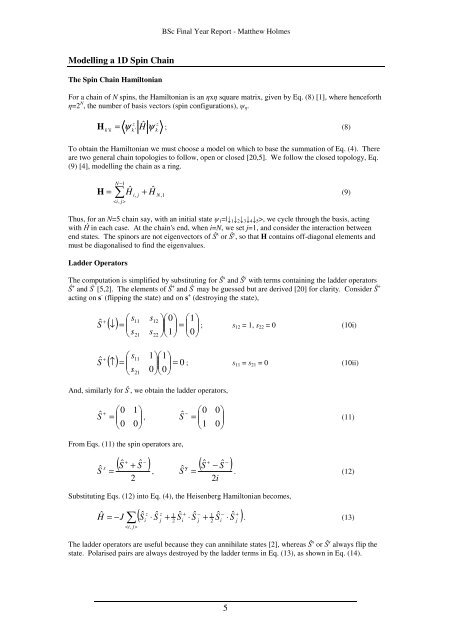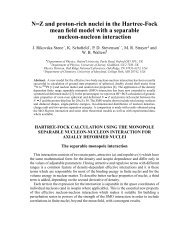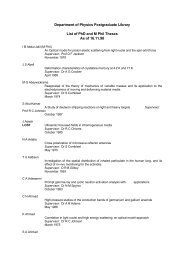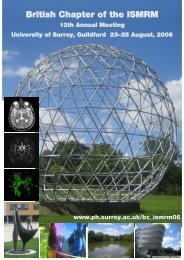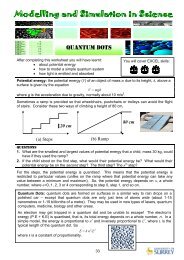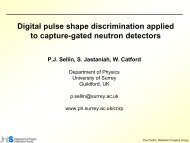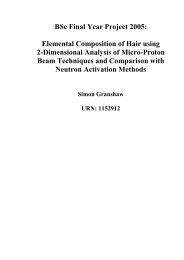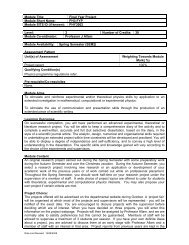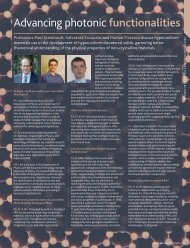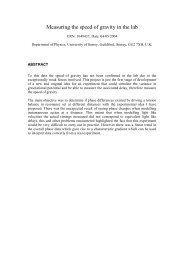The Heisenberg Antiferromagnet and the Lanczos Algorithm Abstract
The Heisenberg Antiferromagnet and the Lanczos Algorithm Abstract
The Heisenberg Antiferromagnet and the Lanczos Algorithm Abstract
Create successful ePaper yourself
Turn your PDF publications into a flip-book with our unique Google optimized e-Paper software.
BSc Final Year Report - Mat<strong>the</strong>w HolmesModelling a 1D Spin Chain<strong>The</strong> Spin Chain HamiltonianFor a chain of N spins, <strong>the</strong> Hamiltonian is an x square matrix, given by Eq. (8) [1], where henceforth=2 N , <strong>the</strong> number of basis vectors (spin configurations), .H ψ H ˆ ψ ; (8)k ' k=zk 'zkTo obtain <strong>the</strong> Hamiltonian we must choose a model on which to base <strong>the</strong> summation of Eq. (4). <strong>The</strong>reare two general chain topologies to follow, open or closed [20,5]. We follow <strong>the</strong> closed topology, Eq.(9) [4], modelling <strong>the</strong> chain as a ring.N 1= − ˆ + Hˆ>HH (9)< i,ji,jN ,1Thus, for an N=5 chain say, with an initial state 1 =| 1 2 3 4 5 >, we cycle through <strong>the</strong> basis, actingwith in each case. At <strong>the</strong> chain's end, when i=N, we set j=1, <strong>and</strong> consider <strong>the</strong> interaction betweenend states. <strong>The</strong> spinors are not eigenvectors of x or y , so that H contains off-diagonal elements <strong>and</strong>must be diagonalised to find <strong>the</strong> eigenvalues.Ladder Operators<strong>The</strong> computation is simplified by substituting for x <strong>and</strong> y with terms containing <strong>the</strong> ladder operators + <strong>and</strong> - [5,2]. <strong>The</strong> elements of + <strong>and</strong> - may be guessed but are derived [20] for clarity. Consider +acting on s - (flipping <strong>the</strong> state) <strong>and</strong> on s + (destroying <strong>the</strong> state),ˆs 11 12 ( ↓) = = +S ; s 12 = 1, s 22 = 0 (10i)ˆ ss21ss122011 11 ( ↑) = = 0 s210010+S ; s 11 = s 21 = 0 (10ii)And, similarly for - , we obtain <strong>the</strong> ladder operators,+ 01− 00Ŝ = , = 0010From Eqs. (11) <strong>the</strong> spin operators are,( ˆ ˆ −ˆ S )+ + S( SˆSˆ−)S x =, Sˆ+ y −=2Ŝ (11)Substituting Eqs. (12) into Eq. (4), <strong>the</strong> <strong>Heisenberg</strong> Hamiltonian becomes,H = −J2iz z + − − +( Sˆ⋅ Sˆ+ Si⋅ Sj+ Si⋅ Sj)i j1 ˆ ˆ 1 ˆ ˆ22< i,j>. (12)ˆ . (13)<strong>The</strong> ladder operators are useful because <strong>the</strong>y can annihilate states [2], whereas x or y always flip <strong>the</strong>state. Polarised pairs are always destroyed by <strong>the</strong> ladder terms in Eq. (13), as shown in Eq. (14).5


